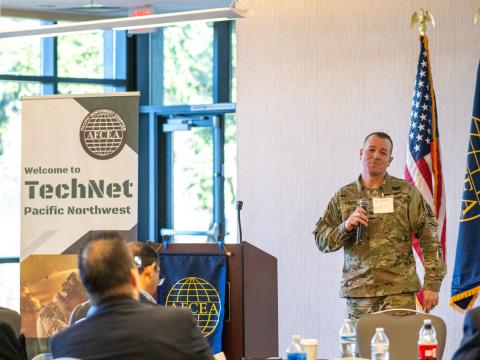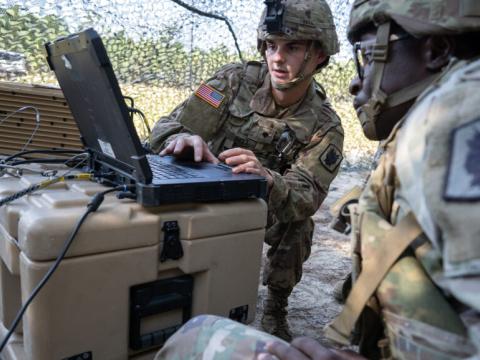Turkey Gains Mobile Network Bonanza
Tactical internet affords immediate battlefield picture to commanders using new multiband, multirole radios.
The Turkish army is conducting field trials with a new broad bandwidth, wide-area digital battlefield communications system. This prototype system is designed to provide a common picture of the battlefield in near real time, sharing multimedia information among and between operating systems.
Developers of this tactical area communications system, which uses the Turkish acronym TASMUS, claim that by digitizing the battlefield, combat power can be concentrated effectively and decisively. Once developmental army trials with the prototype system are completed by the end of the year, TASMUS is slated to enter production under an approximately $500 million contract over 10 years. Developmental costs are roughly $110 million, depending on whether redesign changes will be necessary following field trials.
This mobile and secure network system is being developed by Aselsan Communications Division in Ankara. TASMUS is structured to be self-healing so that if a node is damaged or destroyed, each radio within the system will seek to re-establish communications, reroute itself or act as a relay for other radios. This radio performance endorsement is from M. Atila Akay, director of engineering and product quality, and Senol Uzun, technical leader, electronic design, at Aselsan. “The network is survivable and flexible, supporting voice, data and video for tactical commanders at all levels,” Akay asserts.
In addition to high-speed data exchange, TASMUS fuses and displays intelligence information for commanders at various levels, from battalion to division. This capability extends to rapid exchange of targeting data from sensors to weapons, they add during an interview at Eurosatory 2000 at Le Bourget Airport outside Paris. “The communications system, designed to post-2000 standards, uses asynchronous transfer mode (ATM) and integrated services digital network (ISDN) switching,” Akay discloses. Both men consider switching to be a key element in the network design. “The backbone network for communications is ATM-based technology from Netas, another Turkish company located in Istanbul,” Uzun adds. A large share of Netas is owned by Nortel Networks.
The use of radio equipment for TASMUS is based on time division multiple access (TDMA) technology, which Uzun insists is important in a broadband system. The TASMUS architecture encompasses the multiband, multirole radio family known as iSTAR, an integrated services tactical radio. The radios provide electronic counter countermeasures, low probability of intercept, low probability of detection, and built-in encryption. iSTARs offer radio networking, simultaneous voice and data, near-real-time packet switching, and global positioning system (GPS) functions.
An example of iSTAR is the 5100 tactical radio family based on products such as the RT-5101 mobile subscriber terminal, RT-5114 personal subscriber terminal, and the RT-5102 gateway radio for access to TASMUS. These three radios have the same frequency on-the-air interface, which enables them to communicate with one another. The radios interface with the tactical area communications ATM switching backbone, Uzun asserts.
The 5100s can operate in several configurations: the VRC-5110, a 50-watt mobile vehicular subscriber terminal; the VRC-5115, a 50-watt gateway radio rack-mount unit; and the PRC-5114, a 2-watt personal-subscriber manpack radio. Using direct sequence spread spectrum, voice coding of 4.8 CELP (code exited linear prediction) and an on-the-air transmission rate of 380 kilobits per second, iSTARs operate in a frequency of 225 to 400 megahertz. The radios asynchronous data rate is 1,200 to 9,600 bits per second, and the synchronous data rate is 1,200, 9,600 and 64,000 bits per second. Packet data, such as X.25, travels at 2,400, 4,800 and 9,600 bits per second, and near-real-time packet data travels at the same rates.
The iSTAR radios are designed to form the mobile subsystem services for TASMUS. These radios can be used independently of TASMUS as an isolated network. The 5100s also provide combined functions of single channel radio access and broadband packet radio. The TDMA channel access scheme divides time into frames and frames into slots. The 5100 uses short time slots to transmit and receive information, Uzun discloses. Using the TDMA scheme, iSTAR radios share the same radio frequency channel; 30 half-duplex channels are available in a 5100 iSTAR TDMA frame, he acknowledges.
5100 iSTAR radios form a network automatically in the tactical area and provide integrated communications to all of the network’s users. Network management functions are carried out in a distributed fashion without the need for centralized management. The iSTAR radio network features multihop communications. Every radio can act as a relay to the voice or data connections of other radios without interrupting communications services to its own user. A maximum of three hops can be used for voice and five hops for data communications. Uzun allows that the multihop feature extends the range of mobile communications and increases the radio network’s survivability.
Voice communications with the 5100 radios provide supplementary services such as priority, pre-emption, call holding, call transfering, call forwarding, call waiting and camp on busy. Circuit-switched data communications with asynchronous interfaces enable live video information over all of the radios. The 5100s support packet-switched data communications, with users establishing 32 simultaneous X.25 virtual circuits to other subscribers. Near-real-time packet-data circuits link sensors and weapons. Very low end-to-end time delay is associated with this type of data communications, Uzun stresses.
The RT-5102 is the gateway for the iSTAR network to the ATM switching backbone. It has a 2-megabits-per-second ATM interface over which all communications and supplementary services of the network are supported. The network’s position location and reporting capability rides on the internal global positioning systems (GPS) receivers of RT-5101 and 5102 radios to obtain position location from the satellites. The GPS information is automatically distributed in the network, enabling a real-time picture of the battlefield for tactical commanders, Akay clarifies.
Uzun continues that TASMUS is designed in the shape of a star—each point provides specific functions such as maneuver control, intelligence and electronic warfare, fire support, air defense and combat service support. This mobile network’s functions encompass a wide-area subsystem; a nodal point that includes an ATM nodal switch, an ISDN access switch; a local area subsystem and a mobile subsystem. The system’s information services are real-time battlefield pictures, digital map and geographic information, meteorological information, intelligence reports and logistics information.
An integrated solution for tactical communications is TASMUS plus a new 9600 radio family, Uzun suggests. Among the system’s radios developed by Aselsan is the PRC/VRC-9600, a frequency hopping family of very high frequency (VHF) frequency modulation (FM) military equipment. Totally designed and developed by the company, this radio provides reliable voice and data communications to friendly forces in the presence of a dense electronic warfare threat, he relates.
The 9600 series is compatible with North Atlantic Treaty Organization (NATO) and International Telecommunications Union (ITU) standards and is interoperable with existing VHF/FM combat network radios. “System interoperability will be tested during upcoming exercises with European allies and the United States,” Akay explains. He continues that the 9600’s electronic protection features are frequency hopping, voice and data encryption, burst transmission, anti-spoofing and radio frequency output power control.
The 9600 family operates in the 30- to 108-megahertz frequency band, with channel spacing of 25 kilohertz for 3,120 channels. System auxiliary operating modes involve automatic voice and data retransmission, break-in, hailing, operation code transmission and active and passive late entry. The frequency hopping rate is 200 hops per second. Subsystem features include network planning and code or key distribution and remote control via vehicle, wireline and computer.
Another key element in the TASMUS architecture is the use of Aselsan’s GRC-5211 Band III E1 radio-link equipment. This system is a tactical digital 2.048-megabits-per-second time-duplex radio that operates at the frequency band of 1.35 to 2.7 gigahertz, NATO Band III, Uzun reveals. The GRC-5211 is designed to provide jam-resistant data communications in the tactical area, coping with the most extreme jamming threats by using four separate simultaneous radio channels. Each channel has direct sequence and frequency hopping features, he warrants. Adaptive output power control, channel coding and interleaving are additional electronic protection measures of the radio link.
The GRC-5211 is designed for ATM requirements and uses a forward-error-correction algorithm developed by the company, Uzun says. The bit error rate of the radio is greater than 10-8 during normal weather conditions and at a distance of 50 kilometers (31 miles). With the TDMA feature in the network, up to 10 GRC-5211 radios can be operated simultaneously within the same shelter to transmit and receive without interference, Uzun assures.
The personal computer-based remote terminal is for local control, and simple menu-driven instructions with graphical display put the GRC-5211 operator in control. Functions and statistical data displayed from this radio allow an operator to measure the performance of the datalink. GRC-5211s distributed around the tactical area of operations also can be controlled by an operating and maintenance system. Connecting an external GPS receiver to the radio’s port enables transfer of its geographical position to remote terminals and the operating and maintenance system.
A tactical data communications module (TDCM) from Aselsan also provides network-based communications for combat network radio users on the battlefield. The TDCM offers a modem-like interface for computers employed in command and control systems to form a seamless, reliable data communications network to attached computers. This is the case even under changing topology, dynamic connectivity and electronic warfare conditions, Akay confirms. He considers TDCMs together with combat radios to be a step toward the tactical internet. Among the interfaces are Ethernet 10-Base-T, RS232 and V.21bis.
Another of Aselsan’s developments is a mobile command-control center, a highly mobile truck-mounted system designed for peacekeeping and wartime theater deployment. The center collects and evaluates operations and intelligence data and tracks the situation in an area of concern. The data are collected for evaluation using various communications subsystems. The evaluation takes place in a fully computerized environment and uses command-control software. The center’s modular structure allows adaptation to meet different requirements, Akay recounts.
Housed in a NATO Type 1 shelter on a 5-ton truck, the center’s infrastructure includes command-control, communications, communications monitoring and application-specific consoles. The software for the center encompasses geographic information, database, image enhancement and battlefield information collection systems. Communications equipment for the center include the 9600 VHF radio, SKS-4000 digital encrypted radio, a satellite communications terminal, leased line and field telephone. Sensor data inputs are from ground surveillance radars, electro-optic cameras, unattended sensors and direction-finding systems.
Both Akay and Uzun make the case that Aselsan is on the threshold of a mobile tactical internet capability for the Turkish army—one with advanced solutions: adaptive routing, dynamic network management and multilevel error detection and correction.




Comments